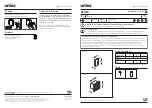
Checking Operation of Fire
Turn on the gas supply at the meter and to the appliance at the isolating cock. Purge the air from the appliance. Press and
turn the gas control anti-clockwise, keep the control fully depressed. The igniter will operate and the pilot will light, check
that the electrode is sparking to the head of the pilot burner, continue until a pilot ignition is established. 0nce a pilot-
flame has been established; keep the control depressed for a further 20 seconds. Release the gas control and check that the
pilot remains lit. Depress the control knob slightly and rotate anti-clockwise until the index symbol is aligned with the
LOW symbol on the indicator label. Release and rotate the control knob to the high position (HIGH symbol) and allow
the appliance to run for a period of approximately 5 minutes, check for satisfactory flame picture prior to carrying out the
spillage test.
To check the gas pressure at the appliance, allow the coals and the coal bed to cool and turn off the gas supply at the
isolating cock, remove the hexagon headed screw and connect a manometer to the pressure test point. Turn on the gas and
ignite the fire, allow to heat up and check that the gas pressure is 20 +/- 1 mbar any appreciable drop may indicate losses
through pipework. The pressure test point may also be used to check for leakage of the joints to the appliance. Turn ‘OFF’
the gas supply to the fire, remove the pressure gauge, replace the screw and then turn the gas supply 'ON'. Fit the fire
front.
Turn the gas control to the OFF position, wait for 90 seconds, fully depress the gas control, turn to the ignition position
and release the control. Attempt to light the pilot with an already prepared match or taper. If the plot lights the FSD is
faulty.
Spillage Check
The appliance should be run on high setting for at least 5 minutes prior to the test with the front and fret located in
position. The test must be carried out with all windows and doors of the room closed, if an extractor fan is situated in the
room, this test should be repeated with the fan running. If there is a connected room with an extractor fan, the test should
be repeated with all the doors to that room opened and the extractor fan running. All smoke must be drawn into the flue.
If spillage occurs, allow a further 10 minutes. Should spillage still occur examine the chimney for the fault and rectify.
Check for satisfactory clearance of products by positioning a lighted smoke match central to the opening 120mm down
from the canopy and level with the rear edge of the front simulated coal. See Fig. 6A.
Demonstrate the lighting and extinguishing procedures to the user.
Advise that:
The curing effect of heating the coals will cause an initial odour which, although not harmful, may require additional
ventilation until the odour has disappeared.
Any debris or soot is cleaned from the appliance. Advise the customer that they should read their Users Instructions
before operating the fire and always follow the advice in the section headed `Removal of Debris or Soot Deposits'. The
appliance must be serviced annually by a competent person in accordance with these instructions.
Advise that the appliance is fitted with an Oxy-pilot to prevent continued operation in the event of spillage occurring if
the fire shuts ‘OFF’ repeatedly the appliance must be turned off and not used until an expert is consulted. The Oxy-pilot
must not be adjusted or rendered inoperable and replacements must only be the manufacturers supplied part.
Complete the section in the enclosed registration leaflet. Advise that any component part of this appliance be guaranteed
against defective workmanship or faulty materials for a period of twelve months from the date of purchase.
Any such part will be replaced free of charge on receipt of the purchaser’s address at the cost of postage only, provided
that:
•
It is accompanied by the registration section cut out of the booklet, together with the original purchase receipt, which
will be returned with the replacement part.
•
Any installation, repairs or adjustments have been carried out by a competent person, such as the supplier’s
representative or a CORGI registered installer.
Page 8
Summary of Contents for Gas Fire
Page 10: ...Page 10 ...
Page 12: ...Page 12 ...
Page 13: ...Page 13 ...
Page 14: ...Page 14 ...
Page 15: ...Page 15 ...
Page 16: ...Page 16 ...
Page 17: ...Page 17 ...



































